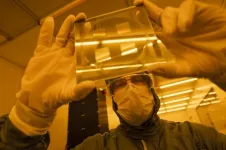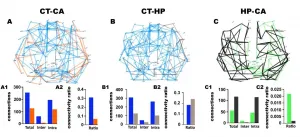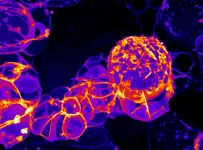(Press-News.org) Monash University researchers have engineered new antimicrobial surfaces that can significantly reduce the formation of bacteria on medical instruments, such as urinary catheters, and reduce the risk of patient infection while in hospital.
This world-first study demonstrates the potential for 3D engineered surfaces in preventing the initial formation of microcolonies of Escherichiacoli (E.coli), Klebsiellapneumoniae and Pseudomonas aeruginosa - the three most common urinary tract bacterial infections (UTIs) associated with catheters.
The study team, led by Dr Victor Cadarso, from Monash University's Department of Mechanical and Aerospace Engineering and the Centre to Impact AMR, engineered surfaces with smooth, 3D micro features, instead of the traditional sharp cross-sectional ones, to reduce the potential for harmful bacteria to attach on these surfaces in large numbers.
The tested surfaces demonstrated reduction in both attachment of bacteria and biofilm formation. One of the surfaces, P01, presented excellent properties against E.coli, K.pneumoniae, and P. aeruginosa with 55 per cent, 69 per cent and 68 per cent less bacterial cells attached, and 53 per cent, 77 per cent and 66 per cent less microcolonies being formed, respectively.
Urinary tract infections (UTIs), associated with urinary catheters, are the most common type of healthcare-associated infections. They have been identified by the World Health Organization (WHO) as an urgent global health threat.
Approximately one in five of hospitalised patients globally are administered urinary catheters during their hospital stay. It is estimated that 13,000 people across the world die each year from UTIs, and a further 700,000 die from associated antimicrobial resistance infections because of the resistance of superbugs to antibiotics and current sterilisation methods.
The study was published in the international journal ACS Applied Materials & Interfaces. Researchers from Monash University's Department of Microbiology were also involved and part of the work was done at the Melbourne Centre for Nanofabrication.
"Using E.coli as an example, we found bacterial cells that form on surfaces do so mostly on the sharp corners. By removing these sharp features, the bacteria can no longer colonise the surface as effectively. This same effect has been demonstrated for the two other pathogens in this study," said Sara Ghavamian, from the Monash Department of Mechanical and Aerospace Engineering, who created these surfaces.
"High-touch surfaces within hospitals, such as catheters and ventilators, are a significant source of microbial spread and healthcare-associated infections.
"Infection control through physically altering the micro architecture of these surfaces, rather than the traditional use of chemical agents, is not only a more durable approach but also an effective strategy for combating antimicrobial resistance."
The bacterial colonisation of surfaces takes place over time. Once bacteria attach to a surface, a series of cellular responses are triggered. After this initial phase, including a few rounds of cell division by this bacteria, microcolonies of hundreds of bacterial cells are formed.
After successful colonisation, the bacteria form a biofilm - a large population of bacteria in a 'secreted cellular matrix' that binds together and protects the cells from antibiotics and the immune system. This might create a superbug that can cause long-term health implications for patients.
Researchers demonstrated that their 3D engineered microtopographies with varying heights and smooth curved cross-sections can simultaneously deter both the initial attachment and the formation of biofilms for three clinically relevant bacteria.
Through an extensive screening process, researchers identified that the sharp corners of the vertical side walls within the conventional micropatterned surfaces gifted bacteria with perfect hiding spots to shelter themselves against the flow of fluids which could wash them away.
The researchers hypothesise that by smoothing out these corners, the bacteria would be left with nowhere to hide.
"After equivalent incubation periods with the same bacteria, we discovered that while the micropatterned surfaces were indeed successful in reducing the number of microcolonies formed they, problematically, increased the number of attached bacteria compared with traditional micro-flat surfaces," Sara said.
"Opposite the conventional sharp micropatterned surfaces, our smooth design demonstrated a simultaneous decrease in both the number of bacterial attachment and microcolony formation compared to the standard flat surfaces.
"Developing strategies to prevent the bacterial colonisation of surfaces, such as catheters, without requiring antimicrobial drugs or chemicals is critical to stop biofilm formation and the potential spread of harmful diseases."
INFORMATION:
Dr Victor J. Cadarso (Monash University, Department of Mechanical and Aerospace Engineering and Centre to Impact AMR) led the study, performed by Sara Ghavamian (Monash University, Department of Mechanical and Aerospace Engineering and Centre to Impact AMR), with research support from Dr Iain Hay (Monash University, Biomedicine Discovery Institute and School of Biological Sciences, University of Auckland) and Professor Trevor Lithgow (Director, Centre to Impact AMR, and Biomedicine Discovery Institute).
The study was performed in part at the Melbourne Centre for Nanofabrication, as well as the Monash Centre for Electron Microscopy, the Ramaciotti Centre for Cryo-Electron Microscopy, the Monash Centre to Impact AMR and Monash University Biomedicine Discovery Institute.
Please visit https://doi.org/10.1021/acsami.1c01902 for more information.
MEDIA ENQUIRIES
Leigh Dawson
T: +61 455 368 260 E: media@monash.edu
For more Monash media stories, visit our news and events site
SALT LAKE CITY - A new study published in the Journal of Clinical Oncology reports findings on Huntsman at Home™, a cancer hospital-at-home model operated by Huntsman Cancer Institute (HCI) at the University of Utah (U of U). The study analyzed aspects of Huntsman at Home acute care--meaning a level of care that is generally provided in an inpatient hospital setting.
In the 30 days after study entry, Huntsman at Home participants had 55% fewer hospitalizations, 45% fewer emergency department visits, and shorter hospital stays by one day. They also had 47% lower health care costs during the same 30-day period ...
A key driver of energy research is the ever-growing demand for energy. Traditional fossil-fuel-based energy sources currently meet these demands and do it well, but they're non-renewable and cause major environmental pollution. In a world with looming climate and resource crises threats, researchers have turned to renewable sources of energy as sustainable alternatives. Among renewables, wind energy, in particular, has gained considerable attention due to its low cost. As Dr. Afef Fekih, Computer Engineer at the University of Louisiana, USA, with a specialization in wind turbine design, notes, "Wind energy has been described as 'the world's fastest-growing renewable energy source', seeing a 30% annual growth on ...
A new survey study suggests that, for adolescents who received unplanned distance education due to the COVID-19 pandemic, experiencing one's own competence was linked to positive emotion, self-motivation to learn, and pro-learning behaviors. Feeling connected to others was also linked to positive emotion. Julia Holzer of the University of Vienna, Austria, and colleagues present these findings in the open-access journal PLOS ONE.
The new research draws on a psychological theory known as self-determination theory, which outlines three basic psychological needs for well-being: autonomy, connection to others, and experiencing one's own competence. Previous research has provided much ...
Americans who get their news from traditional sources (e.g.: TV, newspapers) are more likely to accept the COVID-19 vaccine than those who rely on social media.
INFORMATION:
Article Title: Examining the effect of information channel on COVID-19 vaccine acceptance
Funding: This research was with funding support from Jigsaw, Google. RPL, ES, JK, BH, and CMI received funding from Jigsaw to conduct this research. BG and TV are employed by Jigsaw/Google. Google, Inc. provided support in the form of salaries for authors, BG TV, but did not have any additional role in the study design, data collection and analysis, decision to publish, or preparation of the manuscript. The specific roles of these authors are articulated in the 'author contribution'. The data ...
Almost 1 in 4 COVID-19 patients have another bacterial, viral or fungal infection simultaneously or subsequently, with such patients experiencing worse disease outcomes.
INFORMATION:
Article Title: Prevalence and outcomes of co-infection and superinfection with SARS-CoV-2 and other pathogens: A systematic review and meta-analysis
Funding: NS received research support for this work from the National Institute of Allergy and Infectious Diseases of the National Institutes of Health under Award Number DP2AI144244. The content is solely the responsibility of the authors and does not necessarily ...
Tsukuba, Japan - Autoimmune diseases occur when an individual's immune system fights their own body as if it was a foreign invader. However, in healthy people, these responses are prevented by a process known as immune tolerance. Many complex biological mechanisms maintain the necessary balance between immune activation and suppression to ensure immune tolerance does not prevent the body from effectively fighting pathogens.
In a new study published in PNAS, a group of researchers from the University of Tsukuba uncovered how the relationship between two receptors called DNAM-1 and TIGIT helps preserve the balance for optimal immune function. Both of these molecules have previously been studied ...
Recently published in the scientific journal Brain Communications, a new study distinguished structural patterns between individuals with corpus callosum dysgenesis (CCD), a congenital condition that consists of the absence or incomplete development in the connecting structure between the two brain hemispheres. The research was carried out by the D'Or Institute for Research and Education (IDOR), the University of Pittsburgh, Oswaldo Cruz Foundation (Fiocruz), and the Federal University of Rio de Janeiro (UFRJ).
Investigating CCD is an arduous task for doctors and neuroscientists. There aren't many patients available for research, and the anatomical variability of brains with CCD creates a broad ...
Philadelphia, May 18, 2021 - Many socioeconomically disadvantaged children face poor cognitive and mental health outcomes, and researchers are working to determine the specific factors that link childhood conditions to those poor outcomes, including how they might shape brain circuitry. In a new study, researchers have examined how "neighborhood disadvantage" can affect the developing brain, including the brain's connectivity between regions.
The study appears in Biological Psychiatry: Cognitive Neuroscience and Neuroimaging, published by Elsevier.
Sarah Whittle, PhD, and Divyangana Rakesh, lead authors of the study, studied existing brain scans from 7,618 children aged 9-10 collected as part of the Adolescent Brain Cognitive Development ...
EUGENE, Ore. -- May 19, 2021 -- High-resolution imaging of fruit flies at the University of Oregon has captured mechanical motions that stem cells use to make neurons, the cells that make up the brain.
These motions coordinate cell division with differentiation, where newly born cells become neurons. Differentiation is essential for building the brain circuitry in complex organisms that underlies human cognition and emotions, said Ken Prehoda, a professor in the UO's Department of Chemistry and Biochemistry.
Prehoda was principal investigator of a project published online May 18 in the journal ...
Researchers at UVA Cancer Center have unveiled important new insights into how hormones known as androgens act on our cells - and the discovery could boost efforts to develop better treatments for prostate, ovarian and breast cancers.
The findings shed light on how androgens interact with their receptors inside cells to affect gene activity. This process is important in both healthy cells and certain cancers. Hormone therapy for prostate cancer, for example, aims to reduce the amount of androgen in the body, or to stop it from fueling the cancer cells. However, ...






